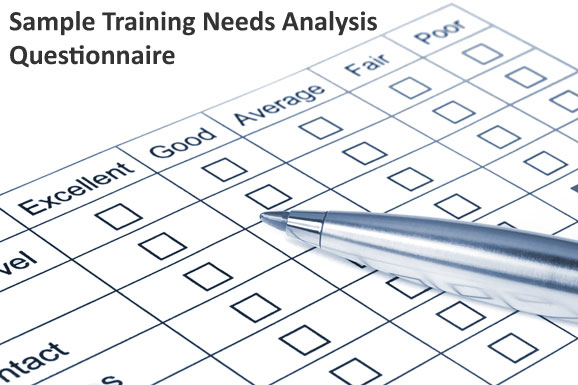



In our previous post giving you sample training needs analysis questionnaires, many readers asked for more samples. We did not create our own sample for the previous post. Now we have. Below you will find a training needs analysis questionnaire you can use or adapt to your own company’s needs.
There is no single type of training needs analysis questionnaire. There are countless versions, as they vary with the user’s industry and needs. This sample training needs analysis questionnaire is just one example, and you can edit it to work for your own business. Please do not ask us to email you other types of questionnaires. This is the only one available, and we do not create custom questionnaires for each reader. It’s easily customizable — just use it as a model and plug in different skills that are most important for your own business. If this one doesn’t meet your exact needs, you can find numerous other examples by searching Google or you can create your own custom template (which is ideally what all HR reps would do, to make sure the questionnaires are appropriate for their personal goals).
The questionnaire below relates to hiring sales staff for a business. The skills included are those companies would generally find important in their sales representatives who are dealing with customers directly. We hope you find it useful. If you want to use this questionnaire as-is, download and print the .pdf version.
Sales Staff Training Needs Analysis
In the questionnaire below, place a check mark in the column that reflects your current level of skill or ability for each skill listed. Rank your skills on a sliding scale, with 1 being poor or beginner-level skills and 5 being strong skills or more advanced experience in that area. Your responses will help us determine your current skill set, so we can plan the most effective training program to help you excel at your job.
| Sales Skills | 1weak | 2 | 3avg. | 4 | 5strong |
| Ability to qualify buyers quickly | |||||
| Identifying customer needs | |||||
| Identifying customer objections | |||||
| Overcoming customer objections | |||||
| Prospecting / cold contacts | |||||
| Conducting presentations | |||||
| Closing the sale |
| People / Communication Skills | 1weak | 2 | 3avg. | 4 | 5strong |
| Listens attentively | |||||
| Shows enthusiasm on the phone | |||||
| Shows enthusiasm face-to-face | |||||
| Friendly / approachable | |||||
| Polite with customers & management | |||||
| Teamwork | |||||
| Understanding customers’ POV | |||||
| Building a rapport with customers | |||||
| Ability to assist / train others |
| General Business Skills | 1weak | 2 | 3avg. | 4 | 5strong |
| Goal-oriented | |||||
| Able to execute managerial orders | |||||
| Skill in using the phone systems | |||||
| Order entry skills | |||||
| Interest in personal development | |||||
| Shows up to work on time (reliable) | |||||
| Understands financial goals |
How to Use this Training Needs Analysis Questionnaire
Whenever you’re conducting a training needs analysis, you’re looking to evaluate the current skills of your staff so you can figure out what areas they need the most training in. Having a proper training plan in place means that workers can work more productively and efficiently, because they’ll have the skills they need to get the job done right.
After distributing a training needs analysis questionnaire like the one above, you have to analyze the results.
The first step of doing that is deciding which of the skills listed are the most important to your business. Mark them or highlight them. Then look at those most important skills and see which of them has the lowest ranking based on employee feedback (the most 1s and 2s for example). These should be your priority areas for employee training. They’re the weakest skill sets in the most important areas for your company.
Once you’ve taken care of training in those areas, you can decide if the questionnaire results show training in other, less important, areas is also worth pursuing.
You may also enjoy reading Why Kinesthetic Learning Really Works in Classrooms Today.